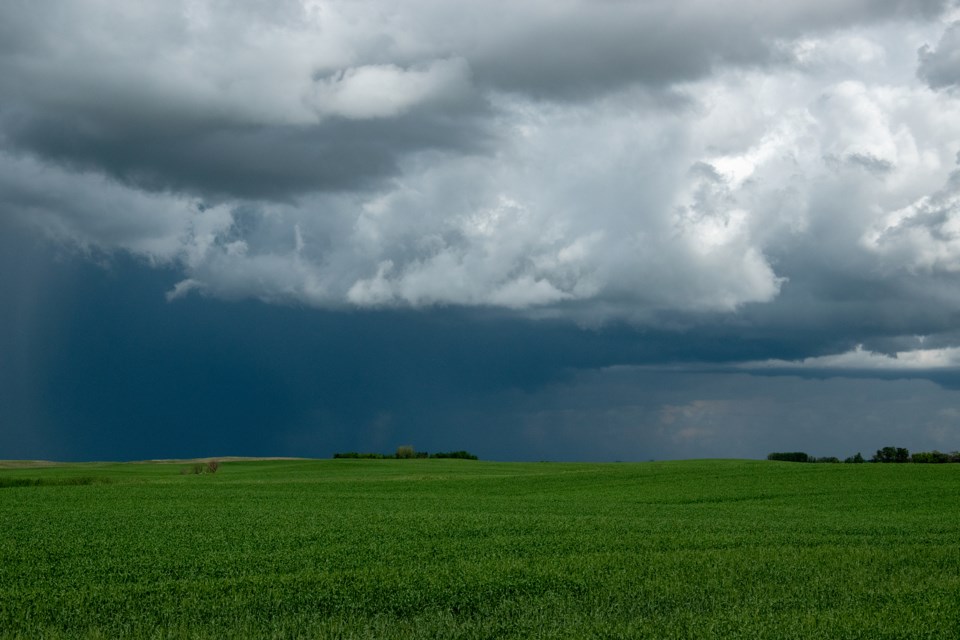EAST CENTRAL — Rain across the region will help to relieve dry soil conditions in the areas where it fell, and encourage germination and growth on cropland, hay land and pasture.
Some other parts of the province weren’t as lucky during the June 11 to 17 period.
Northeastern Saskatchewan
Timely rain fell across most of the region this past week, which will help stressed crops and encourage growth on hay land and pasture. Rainfall ranged from nothing to a substantial 90 millimetres in the Melfort area. The Nipawin area received up to 34 millimetres, the Lake Lenore area up to 51 millimetres, the Birch Hills area 32.5 millimetres and the Prince Albert area 42 millimetres. The Melfort area has received the most precipitation since April 1 (114 millimetres).
Topsoil moisture conditions have greatly improved from the rain. Cropland topsoil moisture is rated as eight per cent surplus, 71 per cent adequate, 12 per cent short and nine per cent very short. Hay land and pasture topsoil moisture is rated as two per cent surplus, 71 per cent adequate, 15 per cent short and 12 per cent very short. Crop District 8A is reporting that 72 per cent of cropland and 69 per cent of hay land and pasture have adequate topsoil moisture at this time. Rain is still needed in the coming weeks to help crop, hay and pasture growth.
Overall, 60 per cent of the fall cereals, 58 per cent of the spring cereals, 39 per cent of the oilseeds and 61 per cent of the pulse crops are at their normal stages of development for this time of year. Crop conditions vary across the region: 34 per cent of the canola, 62 per cent of the spring wheat and 78 per cent of the peas are in good condition at this time.
The majority of crop damage this past week was caused by insects such as flea beetles and cutworms and the lack of moisture.
East Central Saskatchewan
Significant rain over a good portion of the region has helped crop, hay and pasture growth. The Goodeve area received 77 millimetres of rain, the Saltcoats area 45 millimetres, the Lipton area 58 millimetres, the Elfros area 46 millimetres, the Craik area nine millimetres and the Kenaston and Meacham areas three millimetres. The Goodeve area has received the most precipitation since April 1 (118 millimetres). The rain will help crop, pasture and hay growth, but more will be needed to sustain the crops. Some hay fields have prematurely headed out due to the moisture stress.
Topsoil moisture conditions have significantly improved thanks to the rainfall. Cropland topsoil moisture is rated as three per cent surplus, 44 per cent adequate, 32 per cent short and 21 per cent very short. Hay land and pasture topsoil moisture is rated as two per cent surplus, 31 per cent adequate, 39 per cent short and 28 per cent very short. Crop District 6A is reporting that 55 per cent of cropland and 65 per cent of hay land and pasture are very short topsoil moisture at this time.
Some crops are behind their developmental stages for this time of year, but 62 per cent of the fall cereals, 35 per cent of the spring cereals, 25 per cent of the oilseeds and 46 per cent of the pulse crops are at their normal stages of development for this time of year. Crop conditions are highly variable across the region: nine per cent of the canola, 19 per cent of the spring wheat and 14 per cent of the lentils are in good condition at this time. The rainfall will improve crop conditions and encourage growth of crops, pasture and hay.
Crop damage this past week was caused by dry conditions, strong winds and flea beetles.
The crop report is provided each week by the Government of Saskatchewan



